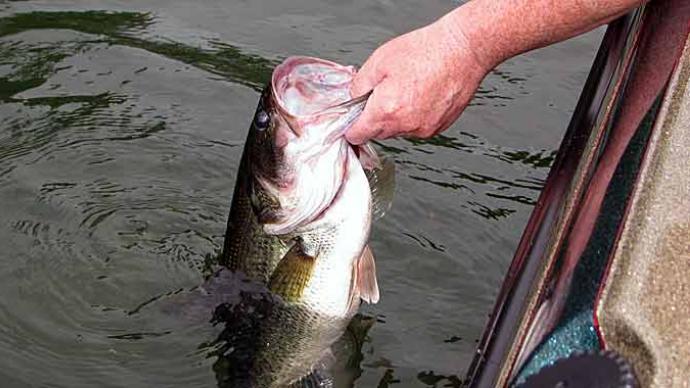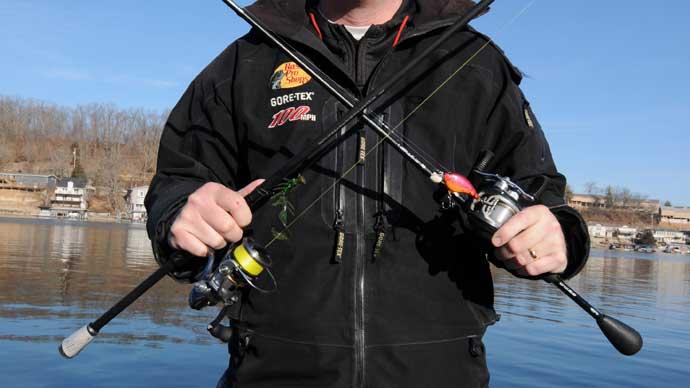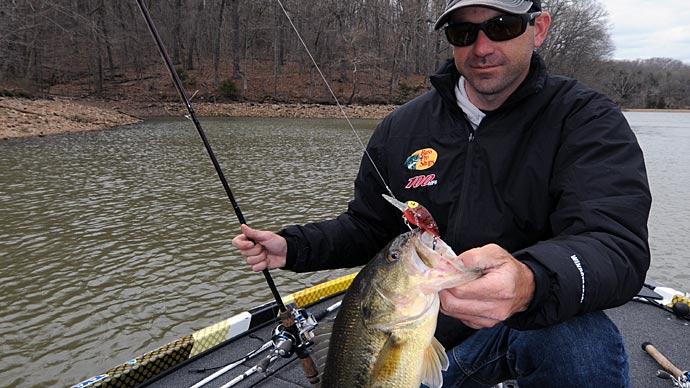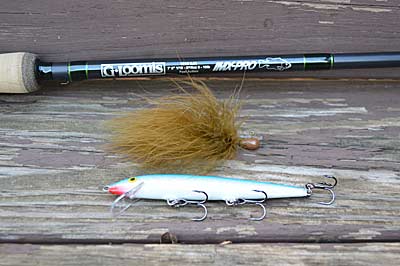
Bass-fishing success is built on fine adjustments. Choose the best line, lure, or what-have-you for the conditions currently off your boat’s bow, and you’ll be rewarded with more bites. And many of those will be from bigger bass.
Spinning outfits aren’t immune to specialization. Rods, for example, are offered in a host of lengths, actions, and powers. Reels are available in different sizes and drag configurations. And both offer components that reduce twists and wind knots, which is an aggravating part of using this equipment. Each combination promises a game-changing sensitivity and function within a particular situation.
But into each life, a little generalization must fall. So within those racks, cases, and lockers overflowing with options are touchstones. And that’s a good thing. Each of these spinning outfits does several things well, preparing you for various on-the-water scenarios, whether fishing from the bank and limited to what you can carry or scouting new-to-you water when finding that first bite is more important than maximizing your productivity with a particular technique.
These three spinning outfits ensure you are prepared, whether fishing shallow or deep, big or small lures, or sparse or heavy cover. So, make sure they are always within reach.
One For Small Lures And Light Line
Some days are more challenging than others on the water when small lures and light lines are the only things big bass will bite. So, it’s essential always to have a spinning outfit that can handle all three.
This 7-foot, 6-inch spinning rod accomplishes several things. Its light-power and fast-action blank flexes from the tip into its midsection. That requires less weight and effort to load, making casting small lures further and more accurately easy. The flex also acts like a shock absorber, softening a big smallmouth’s leaps and lunges, protecting lines as light as 6-pound test from breaking.
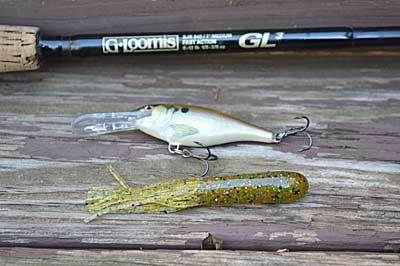
But the rod is only half of a spinning combo. You need a reel, too. Gear ratios are relatively standard across the spinning-reel spectrum, so don’t spend much time contemplating them. Instead, look at a reel’s weight. Lighter ones take some of the strain out of all-day fishing trips. A large-diameter spool collects line in bigger wraps, which reduces coiling in fluorocarbon and monofilament lines and thus tangles when casting. You also want a front drag, whose larger diameter washers slip easily, reducing the chance the line will break before the spool slips.
This spinning outfit works well with a 300- or 3000-size reel. A whisker heavier than the ubiquitous 2500-size reels, it helps balance the rod’s longer length and has a slightly larger spool. Spool it with 6- or 8-pound test braided line. Its lack of memory allows it to flow off the spool with little effort, helping launch lightweight lures further. If the water is clear and you feel its presence will spook fish, tie in a leader with an FG knot or Alberto. They slip easily through line guides, so you can tie a leader long enough to allow you a few chances to re-rig your offering.
This spinning outfit is built for little lures and big bass and shines in several situations. Use it to twitch balsa minnows, such as Rapala's Original No. 11 Floater, for spooky springtime bass cruising in shallow water. And it will handle small soft-plastic lures, whether a lightly weighted tube bait, Texas-rigged finesse worm, or small wacky rigged worm.
But this combo shines with marabou jigs, which have become the darlings of anglers chasing bomber bronzebacks swimming in shallow water that's crystal clear, especially in the Great Lakes. Moreover, it can cast these lightweight offerings — 1/16 ounce is the most popular size — far away from the boat, where sights and sounds can spook these bass.
This spinning outfit is best for fishing shallow water patterns, though you could make it work for deep-water presentations in a pinch. But better options exist, including the second of these three must-have spinning rods.
One For Multitasking
In today’s crowded specialized world, the importance of a multitasker has been lost. Bring it back to the forefront with this combo. It handles various situations, making it easy to switch between them without missing a beat. And if your primary approach is bank fishing, you'll have less to carry and navigate around brush as you walk to your favorite honey hole.
The rod should measure between 6 feet, 6 inches, and 7 feet long. That will provide casting distance while being short enough to fish vertically comfortably. A relatively short rod is essential for the latter because it keeps your lure close to the boat and within sight of your electronics. Its versatility also comes from its medium-heavy power, which can handle a range of lure weights. And a fast action will ensure you can work them.
The reel should be a 2500 size. Its large spool, which should have a front-mounted drag, will easily handle a range of line sizes and nearly eliminate snarls such as wind knots. This outfit works equally well with fluorocarbon, monofilament, or braided line. So, choose the best one for you and the current conditions. But if you want to stretch your fishing dollar, go with a braided line and a fluorocarbon or monofilament leader. The nearly indestructible braid provides seasons of use — more if you spool it on a second reel in reverse — because you only will change the leader, which can be finetuned to conditions.
This outfit straddles your bass fishing needs in shallow and deep water. Sure, it will cast a tube or grub to an outside weed edge or windblown point. And small crankbaits, such as those used in cold water, are no problem. But it will handle a drop shot or Ned rig as deep as you have line on its reel. In addition, it's more comfortable to cast, thanks to a slightly shorter length. So, accurate casts to shallow water cover are effortless.
One For Big Jobs
Spinning rods aren’t only for little lures and light lines. They can do heavy lifting, too. While they won’t replace a flipping stick, they can present hard-to-cast lures into heavy cover easier than their baitcasting cousins. And this one completes your spinning trifecta.
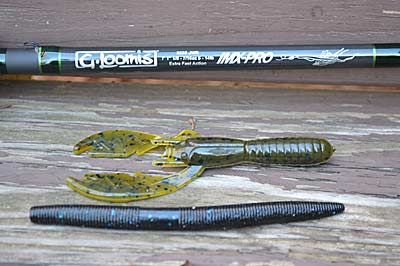
This spinning outfit begins with a rod that measures 7 feet long. It should sport a heavy action that can handle lines as strong as 20-pound test and lures that weigh upwards of ¾ ounce. Its fast action will keep its flex in its tip. That will increase casting accuracy, especially when skipping lures across the surface.
Choose a rod with a full grip. It will feel more comfortable when tucked under your arm while hauling hawgs from heavy cover. Next, attach a 300-size spinning reel. Its large spool will help line payout easily and with fewer tangles, making soft pitches and skips to sweet spots easy. Anyone who has tried to cast heavy monofilament or fluorocarbon line with a spinning reel, only to watch its memory cause it to “explode” off the spool, will appreciate this. And a front-mounted drag will allow you to lock down the spool for solid hook sets and complete control while battling a bass.
Braided line is the best choice when it comes time to fill your reel’s spool. It’s nearly indestructible, standing up to the most abrasive dock posts, brush piles, and aquatic vegetation beds. And because that amount of heavy cover will hide your line, you won’t need a leader. So, tie it directly to your lure.
This spinning outfit handles Texas-rigged soft-plastic lures, including stick worms such as Yamamoto's Senko. They can be tricky to cast on baitcasting gear, especially when rigged weightless. But it can put one spot under a dock surrounded by matted aquatic vegetation or at the trunk of a laydown still sporting all its branches. And it has the muscle to extract bass from those scenarios.
You’ll assign this outfit to more duties the more you use it. It’ll handle casting finesse jigs to rocky banks in early spring and working soft jerkbaits along edges of aquatic vegetation for summertime smallmouth. Its balance of power and precision is versatile.


